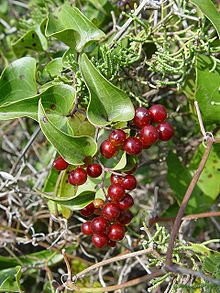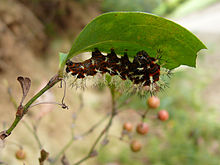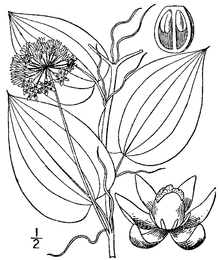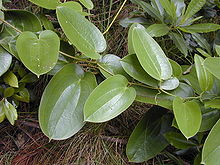- Smilax
-
- For another plant sometimes called Smilax see Asparagus asparagoides.
Smilax 
Mediterranean Smilax (Smilax aspera) in fruit Scientific classification Kingdom: Plantae (unranked): Angiosperms (unranked): Monocots Order: Liliales Family: Smilacaceae Genus: Smilax Species Some 300-350, see text
Synonyms Nemexia
Smilax is a genus of about 300-350 species, found in temperate zones, tropics and subtropics worldwide. In China for example about 80 are found (39 of which are endemic), while there are 20 in North America north of Mexico.[1] They are climbing flowering plants, many of which are woody and/or thorny, in the monocotyledon family Smilacaceae, native throughout the tropical and warm temperate regions of the world. Common names include catbriers, greenbriers, prickly-ivys and smilaxes. "Sarsaparilla" (also zarzaparrilla, sarsparilla) is a name used specifically for the Jamaican S. regelii as well as a catch-all term in particular for American species. Occasionally, the non-woody species such as the Smooth Herbaceous Greenbrier (S. herbacea) are separated as genus Nemexia; they are commonly known by the rather ambiguous name "carrion flowers".
Greenbriers get their scientific name from the Greek myth of Krokus and the nymph Smilax.[2] Though this myth has numerous forms, it always centers around the unfulfilled and tragic love of a mortal man who is turned into a flower, and a woodland nymph who is transformed into a brambly vine. (Compare the story of Barbara Allen and sweet William: They buried Barbara in the old church yard / They buried Sweet William beside her / Out of his grave grew a red, red rose / And out of hers a briar.)
Contents
Description and ecology
On their own, Smilax plants will grow as shrubs, forming dense impenetrable thickets. They will also grow over trees and other plants up to 10 m high, their hooked thorns allowing them to hang onto and scramble over branches. The genus includes both deciduous and evergreen species. The leaves are heart-shaped and vary from 4–30 cm long in different species.
Greenbrier is dioecious. However, only about one in three colonies have plants of both sexes. Plants flower in May and June with white/green clustered flowers. If pollination occurs, the plant will produce a bright red to blue-black spherical berry fruit about 5–10 mm in diameter that matures in the fall.
The berry is rubbery in texture and has a large, spherical seed in the center. The fruit stays intact through winter, when birds and other animals eat them to survive. The seeds are passed unharmed in the animal's droppings. Since many Smilax colonies are single clones that have spread by rhizomes, both sexes may not be present at a site, in which case no fruit is formed.
Smilax is a very damage-tolerant plant capable of growing back from its rhizomes after being cut down or burned down by fire. This, coupled with the fact that birds and other small animals spread the seeds over large areas, makes the plants very hard to get rid of. It grows best in moist woodlands with a soil pH between 5 and 6. The seeds have the greatest chance of germinating after being exposed to a freeze.
Besides their berries providing an important food for birds and other animals during the winter, greenbrier plants also provide shelter for many other animals. The thorny thickets can effectively protect small animals from larger predators who cannot enter the prickly tangle. Deer and other herbivorous mammals will eat the foliage, as will some invertebrates such as Lepidoptera (butterflies and moths), which also often drink nectar from the flowers.
Among the Lepidoptera utilizing Smilax are Hesperiidae like the Water Snow Flat (Tagiades litigiosa), Pieridae like the Small Grass Yellow (Eurema smilax)[verification needed], or moths like the peculiar and sometimes flightless genus Thyrocopa. But particularly fond of greenbriers are certain Nymphalidae caterpillars, for example those of:
- Faunis – duffer butterflies
- Kaniska canace – Blue Admiral (on China Smilax, Smilax china)
- Phalanta phalantha – Common Leopard (on S. tetragona)
Uses
An extract from the roots of some species – most significantly Jamaican Sarsaparilla (S. regelii) – is used to make the sarsaparilla drink and other root beers, as well as herbal drinks like the popular Baba Roots from Jamaica. The roots may also be used in soups or stews. The young shoots can be eaten raw or cooked and are said to taste like asparagus, and the berries can be eaten both raw and cooked. Fúlíng jiābǐng (traditional Chinese: 茯苓夾餅; simplified Chinese: 茯苓夹饼), the famous snack from the Beijing region, is named after its key ingredient fúlíng – a quite literal translation would be "stuffed Smilax pancakes". S. glabra is used in Chinese herbology. It is also a key ingredient in the Chinese medical dessert guīlínggāo, which makes use of its property to set certain kinds of jelly.
The powdered roots of Jamaican Sarsaparilla are known as Rad. Sarzae. Jam. in pharmacy and are used medicinally as a cure for gout in Latin American countries. Jamaican Sarsaparilla contains at least four phytosterols of the progesterone class, and is therefore recommended by herbalists as a remedy for the symptoms of premenstrual syndrome. It appears to be most effective at alleviating these symptoms in premenopausal women over the age of 35. Smilax preparations, for example of S. china, are also commonly used in herbalism to treat certain skin diseases which are caused or aggravated by hormonal imbalance, such as psoriasis and seborrhoeic dermatitis. Köhler's Medicinal Plants of 1887 discusses the American Sarsaparilla (S. aristolochiifolia), but as early as about 1590, the Persian scholar Imad al-Din Mahmud ibn Mas'ud Shirazi gave a detailed evaluation of the medical properties of Chinaroot, especially its use against syphilis.
Diosgenin, another steroidal sapogenin, is reported from S. menispermoidea. Other active compounds reported from various greenbrier species are parillin (also sarsaparillin or smilacin), sarsapic acid, sarsapogenin and sarsaponin.
Due to the nectar-rich flowers, species like S. medica and S. officinalis are also useful honey plants.
The common floral decoration smilax is Asparagus asparagoides.[3][4] For example, in the stage version of Harvey, the opening scene describes the home as being "festooned with smilax".
Species
The genus is divided into a number of sections. Section Smilax includes "woody",[5] prickly vines of temperate North America, for example Cat Greenbrier (S. glauca) and Common Greenbrier (S. rotundifolia).[6] Section Coprosmanthus includes unarmed herbaceous plants of temperate North America, for example "carrion flowers" like the Smooth Herbaceous Greenbrier (S. herbacea).[6]
Here is a partial list of species:
- Smilax amaurophlebia Merr.
- Smilax anamitica Kuntze
- Smilax aristolochiifolia Mill. – American Sarsaparilla
- Smilax aspera L. – Mediterranean Smilax, Common Smilax, Rough Smilax
- Smilax auraimensis Steyerm.
- Smilax australis R.Br. – Lawyer Vine, Barbwire Vine, "wait-a-while" (Australia)
- Smilax balansaeana H.Bon ex Gagnep.
- Smilax balbisiana – Chainy Root
- Smilax bella J.F.Macbr.
- Smilax benthamiana A.DC.
- Smilax biltmoreana
- Smilax biumbellata T.Koyama
- Smilax blumei A.DC.
- Smilax bona-nox L. – Saw Greenbrier
- Smilax bracteata Presl
- Smilax brasiliensis Sprengel. – salsaparrilha-do-campo (Brazil)
- Smilax californica
- Smilax campestris Griseb.
- Smilax canariensis
- Smilax castaneiflora Lev.
- Smilax chimantensis Steyerm. & Maguire
- Smilax china L.[7] – China Smilax[verification needed]
- Smilax chingii F.T. Wang & Ts.Tang
- Smilax cinnamomiifolia Small
- Smilax cocculoides Warb.
- Smilax colubrina J.F.Macbr.
- Smilax corbularia Kunth
- Smilax davidiana A.DC.
- Smilax diversifolia Small
- Smilax ecirrata – Upright Greenbrier
- Smilax elegans Wall.
- Smilax elegantissima Gagnep.
- Smilax engleriana Apt
- Smilax excelsa L.
- Smilax extensa A.DC.
- Smilax flavicaulis Rusby
- Smilax gaumeri Millsp.
- Smilax gilva J.F.Macbr.
- Smilax glabra Roxb. – Chinaroot, tufuling (土茯苓)
- Smilax glauca Walter – Cat Greenbrier, Glaucous Greenbrier
- Smilax glyciphylla Sm. – Sweet Sarsaparilla, Native Sarsaparilla (Australia)
- Smilax graciliflora A.C.Sm.
- Smilax grandifolia Buckley
- Smilax griffithii A.DC.
- Smilax havanensis Jacq.
- Smilax helferi A.DC.
- Smilax herbacea L. – Smooth Herbaceous Greenbrier, "carrion flower" (southern Quebec in Canada, Eastern United States)
- Smilax hispida Muhl. – Bristly Greenbrier
- Smilax hongkongensis Seem.
- Smilax hugeri
- Smilax hypoglauca Benth.
- Smilax illinoensis – Illinois Greenbrier
- Smilax immersa A.C.Sm.
- Smilax impressinervia F.T. Wang
- Smilax inversa T.Koyama
- Smilax jamesii G.Wallace
- Smilax kraussiana Meissner
- Smilax krukovii A.C.Sm.
- Smilax laevis A.DC.
- Smilax lanceifolia Roxb.
- Smilax lasioneuron Hook. – Herbaceous Greenbrier
- Smilax lasseriana Steyerm.
- Smilax lata Small
- Smilax latipes Gleason
- Smilax laurifolia L.
- Smilax lemsleyana Craib
- Smilax leptanthera Pennell
- Smilax longipedunculata Merr.
- Smilax luei T.Koyama
- Smilax luzonensis Presl
- Smilax macrophylla Roxb.
- Smilax maculata Roxb.
- Smilax magnifolia J.F.Macbr.
- Smilax mairei Lev.
- Smilax medica Schltdl. et Cham.
- Smilax medicinalis S.Moore
- Smilax megacarpa A.DC.
- Smilax melastomifolia Sm. – Hoi kuahiwi (Hawaiʻi)
- Smilax menispermoidea
- Smilax micro-china T.Koyama
- Smilax microphylla C.H.Wright
- Smilax micropoda A.DC.
- Smilax minutiflora A.DC.
- Smilax moranensis Mart. & Galeotti
- Smilax myosotiflora A.DC.
- Smilax myrtillus A.DC.
- Smilax occidentalis C.V.Morton
- Smilax ocreata DC.
- Smilax opaca (A.DC.) Norton
- Smilax officinalis Griseb.
- Smilax ovalifolia Roxb.
- Smilax ovalifolia Roxb.
- Smilax oxyphylla Wall.
- Smilax pallescens A.DC.
- Smilax panamensis Morong
- Smilax peguana A.DC.
- Smilax perfoliata Lour.
- Smilax phyllantha Gagnep.
- Smilax pilcomayensis Guagl. & S.Gattuso
- Smilax pottingeri Prain
- Smilax prolifera Roxb.
- Smilax pseudochina – False Chinaroot
- Smilax pulverulenta
- Smilax purpusii Brandegee
- Smilax pygmaea Merr.
- Smilax quinquenervia Vell.
- Smilax regelii Killip & C.V.Morton – Sarsaparilla, Jamaican Sarsaparilla (southern Mexico, northern Central America)
- Smilax renifolia Small
- Smilax reticulata Elmer
- Smilax rigida Wall. or Kunth
- Smilax robert-kingii T.Koyama
- Smilax rotundifolia L. – Common Greenbrier (Eastern United States)
- Smilax saülensis J.D.Mitch.
- Smilax siamensis T.Koyama
- Smilax simulans T.Koyama
- Smilax smallii Morong
- Smilax spicata Vell.
- Smilax spinosa Mill.
- Smilax spruceana A.DC.
- Smilax staminea (Griseb.) Forman[verification needed]
- Smilax stans Maxim.
- Smilax stenopetala A.Gray
- Smilax subsessiliflora Poir.
- Smilax synandra Gagnep.
- Smilax tamnoides – Halberd-leaved Greenbrier
- Smilax tenuis Small
- Smilax tetragona
- Smilax velutina Killip & C.V.Morton
- Smilax verruculosa Merr.
- Smilax verticalis Gagnep.
- Smilax walteri Pursh.
- Smilax williamsii Merr.
- Smilax zeylanica L.
Footnotes
- ^ Raven & Zhengyi (2000), FNAEC (2002)
- ^ Mifsud (2002)
- ^ "smilax". Merriam-Webster Online Dictionary. http://www.merriam-webster.com/dictionary/smilax.
- ^ smilax at yourdictionary.com
- ^ Being a monocot, members of the Family Smilacacea can not lay down true wood[citation needed]
- ^ a b FNAEC (2002)
- ^ "6. Smilax china Linnaeus". http://www.efloras.org/florataxon.aspx?flora_id=2&taxon_id=200027905
References
- Flora of North America Editorial Committee (FNAEC) (ed.) (2002): 1. Smilax. In: Flora of North America North of Mexico (Vol. 26: Magnoliophyta: Liliidae: Liliales and Orchidales): 14, 468-469, 474, 477. Oxford University Press. ISBN 0-19-515208-5 HTML fulltext
- Mifsud, Stephen (2002): Wild Plants of Malta & Gozo – Mediterranean Smilax. Retrieved 2008-OCT-02.
- Raven, P. & Zhengyi, W. (2000): : 11. Smilax. In: Flora of China (Vol. 24: Flagellariaceae-Marantaceae): 96. Missouri Botanical Garden Press. ISBN 0-915279-83-5 HMTL fulltext
External links
Wikimedia Foundation. 2010.








